Exploring Shopware: Domains in Shopware 6 Settings

In the following material, we explore a topic specific to the Shopware 6 Cloud environment. Today, you will learn about Shopware domains. When you visit the System section of your Shopware 6 Settings, you may come across the Domains screen situated there. While users of self-hosted shops never see this page, cloud merchants can apply several useful configurations there. Below, we shed light on what Shopware 6 Domains are. You will find out how to add a domain in Shopware 6, what to do with sub-domains, and how to manage a second-level domain within the system. Besides, there is a chapter that explains how to verify a domain in Shopware 6. And you will learn how to remove domains in Shopware 6 if they are no longer necessary.

Note that we provide Shopware integration with external platforms. Contact our support for further information or try our Improved Import & Export Extension for Shopware.
Table of contents
- 1 Shopware 6 Domains Explained
- 2 Shopware 6 Domains Overview
- 3 How to Import Store Data to Shopware 6
- 4 Shopware 6 Essentials FAQ
- 4.1 How to create a Shopware ID?
- 4.2 How to create a Shopware account?
- 4.3 What is Shopware master data?
- 4.4 How to add a shop in Shopware?
- 4.5 How to add a payment method to your Shopware account?
- 4.6 How to create a deposit in Shopware?
- 4.7 How to purchase Shopware extensions?
- 4.8 How to get support in Shopware?
- 4.9 How to migrate to Shopware 6?
- 4.10 How to automate import and export processes in Shopware 6?
- 4.11 How to integrate Shopware 6 with external systems?
Shopware 6 Domains Explained
While creating a Shopware 6 SaaS environment, you face the automated creation of a corresponding URL that combines the specified storefront name and a fixed part the system assigns to it.
However, it is possible to make your Shopware 6 website accessible through any custom domain. You can add the domain in your Shopware 6 settings under the System section on the Domain page.
Note that the maximum number of domains follows your booked plan. Below, we will explain the key points to consider when working with Shopware 6 domains.
Shopware 6 Domains Overview
The Shopware 6 Domains page looks as follows:

As you can see, it doesn’t contain many elements. First of all, you get an overview of the existing domains. In our case, it is “white-ward.shopware.store”.
Besides, it is possible to add your custom domains.
How to add a domain in Shopware 6
To add a new domain in Shopware 6, follow these steps:
- Go to the Domains section under Main Menu -> Settings -> System.
- Click on the Connect domain button.
- Add your domain.
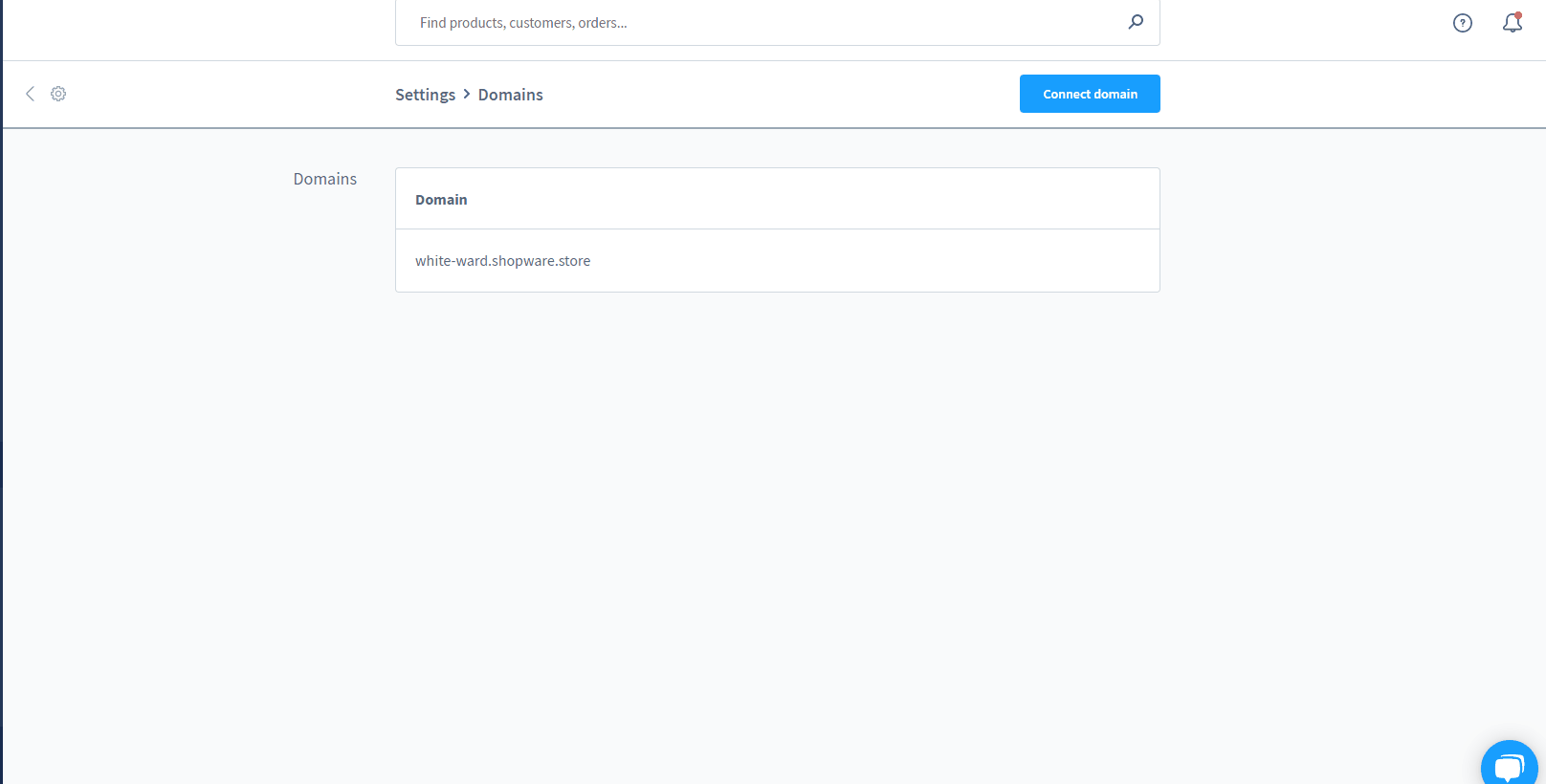
However, adding a new domain is a complex procedure, so we’ve divided it into the following sections.
Bear in mind that removing the domain present in the standard system is impossible. This limitation ensures that at least one domain can be accessed.
The first step of adding a domain in Shopwarte 6 looks as follows:
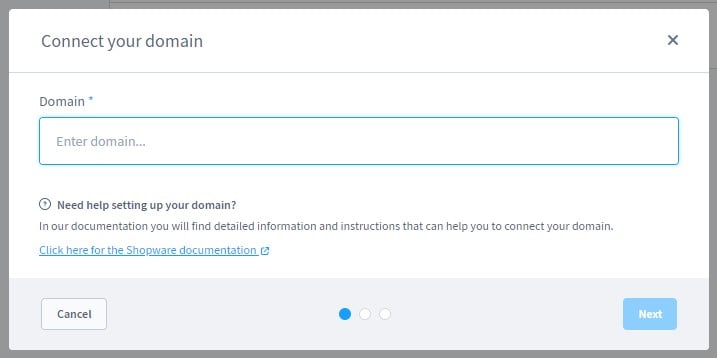
It only requires to specify the desired domain. After the corresponding URL is provided, the Next button is activated.
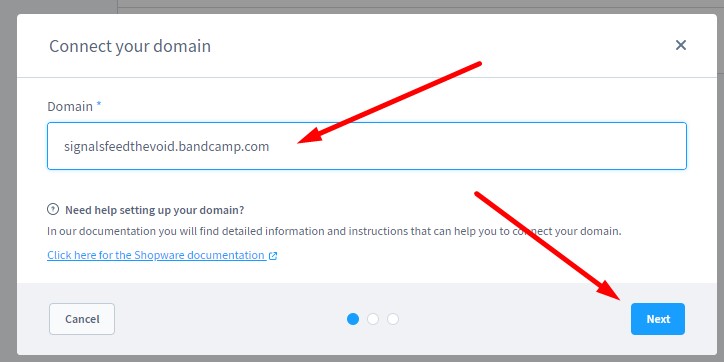
The next steps depend on the use of a normal (second-level) domain and a subdomain.
Sub-domain
If you use a subdomain (e.g. my.shop-website.com), it is necessary to specify the CNAME to establish the connection to the shop. If you are not familiar with the term, a CNAME record or a Canonical Name record is a type of resource record used in the Domain Name System. Its purpose is to map one domain name to another: an alias name to the canonical name.
You set a CNAME record in Shopware 6 as follows:

To use a subdomain in Shopware 6, configure the CNAME for the connection in the DNS configuration of your domain provider.
You should set the CNAME for the part of the subdomain – not the complete address. Peruse the documentation of your provider to get a more in-depth understanding of this configuration. Information about some key hosting providers is available here: .
Normal (second-level) domain
If you use a normal (second-level) domain, such as myshop.com, It is necessary to set the A-record to redirect the domain to your shop. In Shopware 6, you can do that as follows:
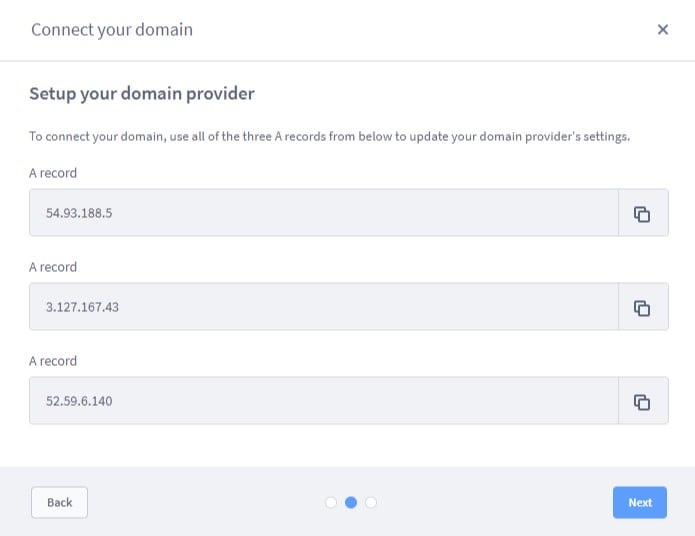
Shopware 6 lets you make your shop accessible through the additional domain. To hit this mark, it is necessary to redirect the domain to the IP addresses of the shop instance. The system lets you achieve the highest reliability since it is possible to provide up to 3 IP addresses (A-records).
Also, you need to perform a few steps at your host or domain provider. It is necessary to redirect your custom domain to at least one of the IP addresses using the A-record. Usually, changes should be applied in the DNS settings of your domain in the control panel. And once again, we should draw your attention to the documentation of your hoster/domain provider – answers to many questions are hidden there.
When the domain is guided to at least one of the IP addresses, you can proceed to the next step – verifying your domain. Note that re-running the check may require returning to the previous step and clicking the Next button.
Also, pay heed to the fact that it may also be necessary to configure the CNAME record – a process that we’ve already described above.
How to verify a domain in Shopware 6
After your domain provider is configured and all the necessary information is delivered to the system, you need to verify a new domain in Shopware 6. Simply click the Next button:
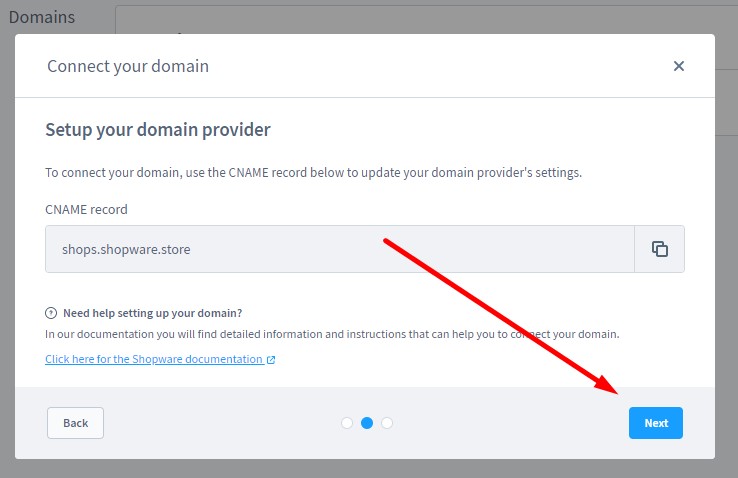
If the provided information is incorrect, you will get the following message:
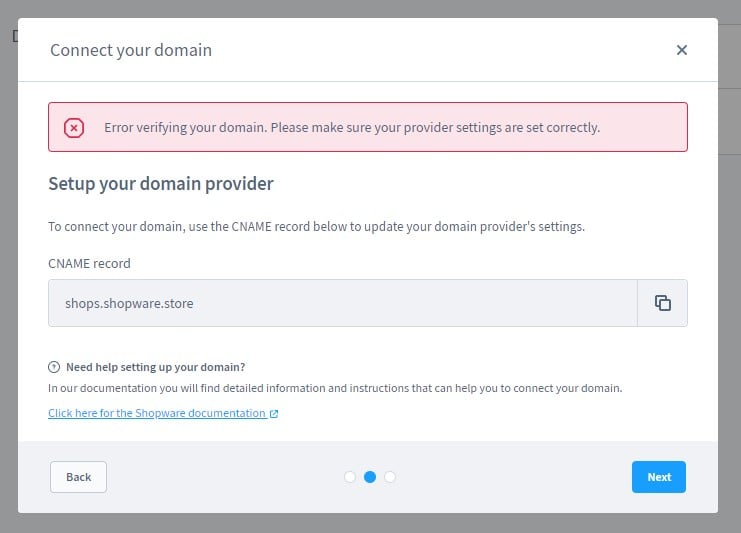
The successful domain verification looks as follows:
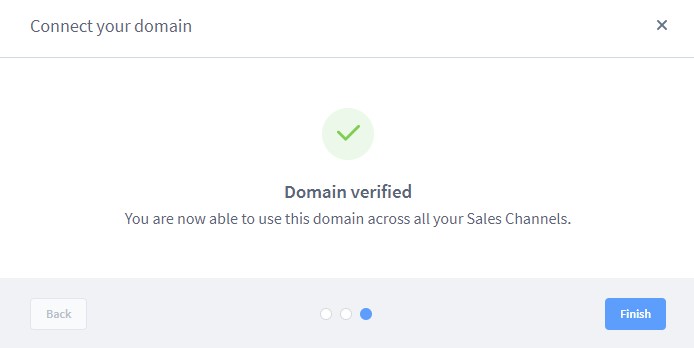
Hit the Finish button to complete the procedure and add your new domain to Shopware 6.
Also, it is worth mentioning that distributing the DNS settings usually takes some time. Therefore, the correct redirection to the shop may fail during the first few attempts.
And don’t forget to assign this domain in the sales channel configuration of your Shopware 6 website. We describe this process in another article.
How to remove an additional domain in Shopware 6
You can remove any additional domain using the context menu – the … button on the right in front of the domain name. Use the Delete option.
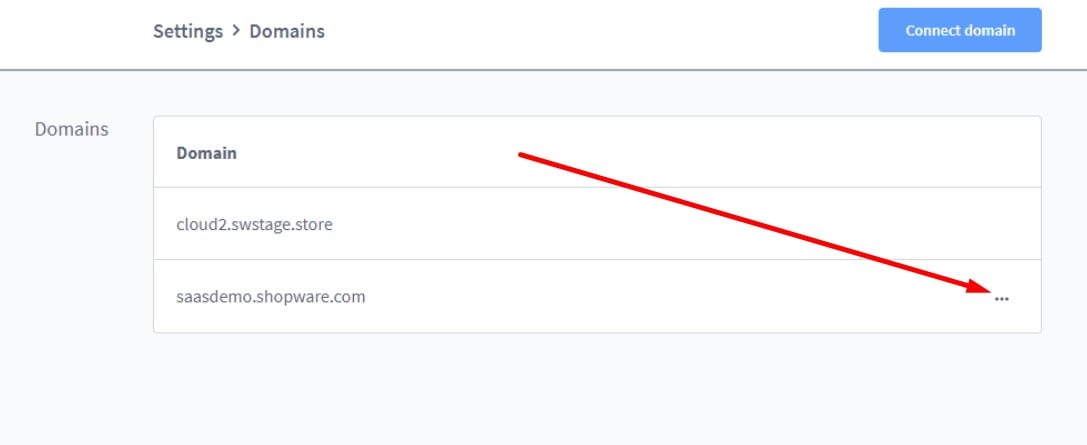
How to Import Store Data to Shopware 6
Our team lets you simplify and automate various processes associated with data migration to Shopware 6. We offer the that enables seamless data transfers. You can use it to import any entities to Shopware 6 from any external platform. The module automates data transfers with the help of a cron-based schedule. Also, it lets you apply mapping schemes to the imported data to make it suitable for Shopware 6 requirements. Contact our support for more details and consult our specialists before using the module for transferring any information to your website. The migration procedure is usually complicated so you need third-party assistance especially if you do that for the first time.
Shopware 6 Essentials FAQ
How to create a Shopware ID?
Receiving a ShopwareID is a simple task since it requires no additional effort. You get it while creating a Shopware account.
How to create a Shopware account?
Visit a registration page to create a Shopware account. Click the Register Now link and proceed to the registration form. When all the data is provided to the system, go to your email to follow the instructions provided in a confirmation message.
What is Shopware master data?
All the information you provide to create a Shopware account is called master data. It includes address, phone, email, name, and other company details.
How to add a shop in Shopware?
Visit your merchant area to launch a new Shopware 6 shop. Click the corresponding link on the start screen’s right part and proceed to the selection of a shop type. You need to choose between a cloud storefront and an on-premise installation. Specify the information required for the selected shop type and save changes.
How to add a payment method to your Shopware account?
Now, let’s see how to add a payment method for internal Shopware purposes. You can do that under Basic Information -> Accounting. Here, you can configure a payment method for internal Shopware purposes, such as purchasing themes and extensions. Choose a method that is more suitable for your business: PayPal, credit card, direct debit.
How to create a deposit in Shopware?
Now, you can create a deposit for your Shopware 6 shop under Merchant Area -> Shops. Choose a shop to provide funds to, click Open Account Details, and initiate the transaction.
How to purchase Shopware extensions?
Now, It is possible to purchase extensions and themes. You can shop either on the Shopware Marketplace or in the Plugin Manager. Choose a software solution and complete the purchase.
How to get support in Shopware?
If you need support regarding your account or license, you can find it here: info@shopware.com or +49 2555 9288 50. If you need support regarding accounting and financial services, look for help here: financial.services@shopware.com and +49 2555 9288 510.
How to migrate to Shopware 6?
Since migration is always a huge and time-consuming endeavor, you need a third-party tool to complete it successfully. We recommend using the Improved Import & Export extension since the default tools of Shopware are not enough to implement seamless data transfers. With our module, you will be able to move core entities to your new website from any external platform. Besides, it is possible to transfer any data from Shopware’s previous versions. We also offer export solutions for other e-commerce platforms to help you migrate from Magento, Shopify, and others. Contact our team for more information.
How to automate import and export processes in Shopware 6?
When it comes to regular data updates, you can also use the Improved Import & Export extension since it provides the ability to automate recurring import and export processes. Create a schedule of updates per each data transfer and let the module do all the work for you. The extension will launch the corresponding data transfer according to the time frames you set.
How to integrate Shopware 6 with external systems?
Integration with various external platforms and systems is no longer a problem if you use the Improved Import & Export extension. You can utilize the module to connect your store to ERPs, CRMs, accounting tools, etc. It automates repetitive import and export processes with the help of cron-based schedules and modifies data according to the requirements of your Shopware store upon import. It is a perfect combination for regular data exchanges between the two systems.









